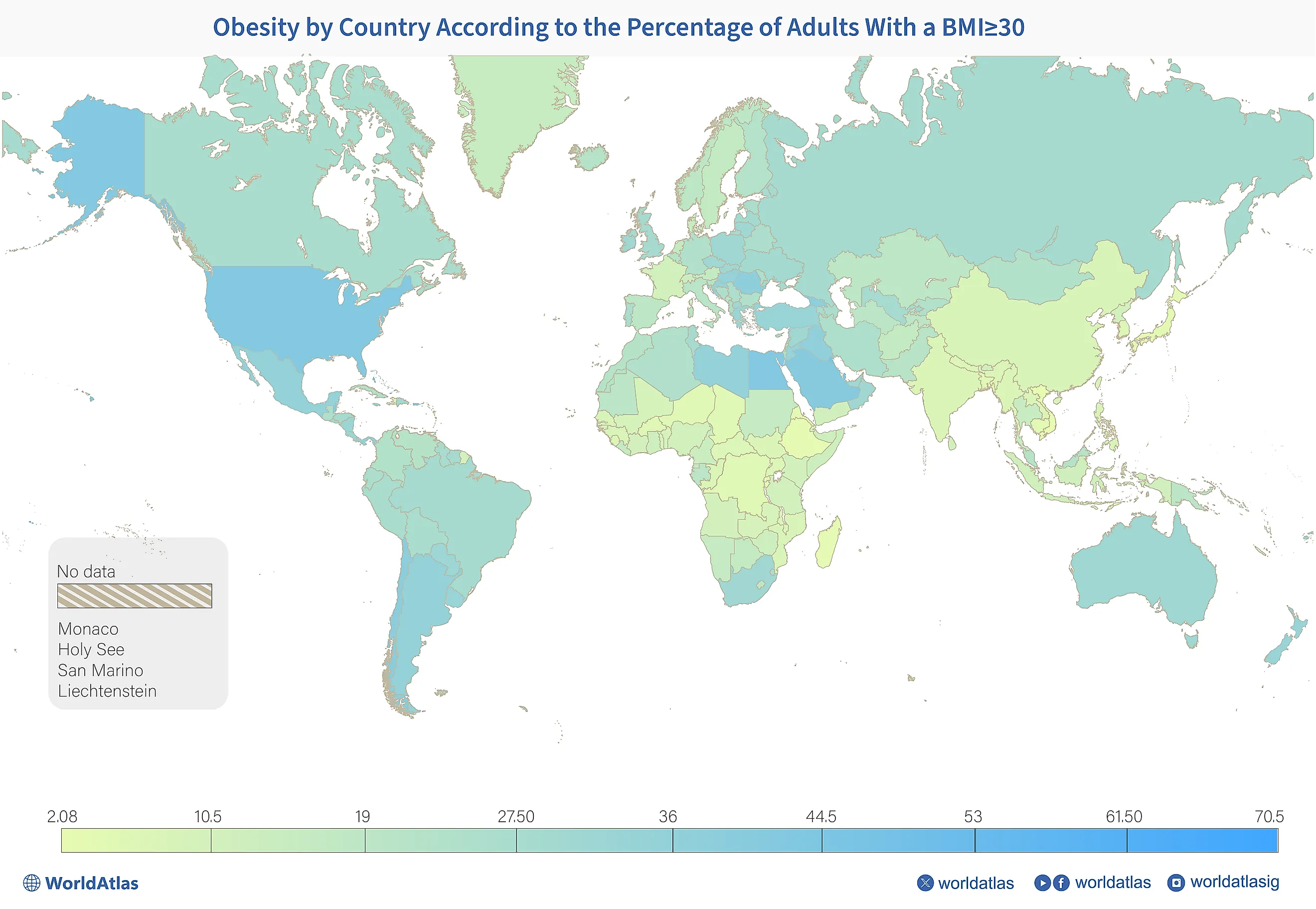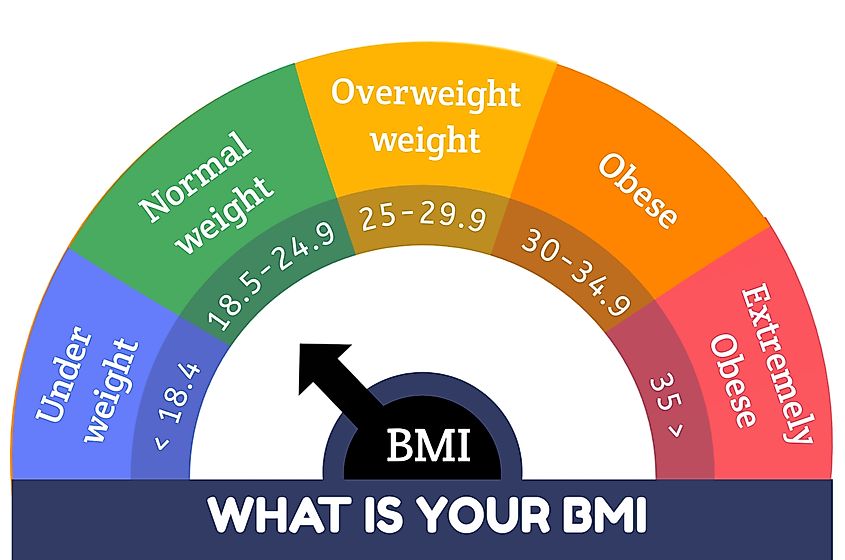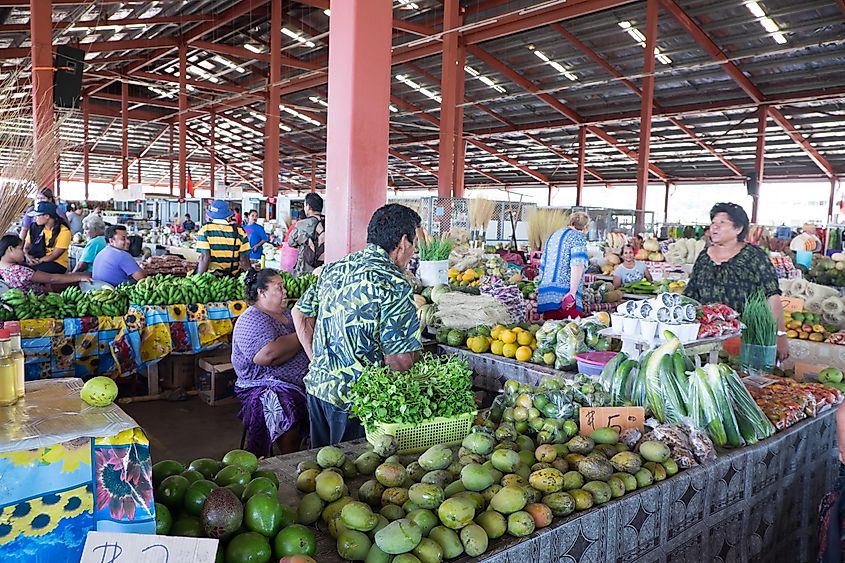
The Most Obese Countries In The World In 2024
According to the World Health Organization (WHO), one in every eight people on Earth is obese. This statistic has more than doubled since the 1990s, and trends suggest that this figure will grow in the coming decades. Levels of obesity are, of course, not shared equally across the world; some countries have considerably higher rates than others.
Tonga is the most obese country in the world, where 70% of all adults are obese according to their BMI. BMI is the metric used to assess obesity in large populations, but it is flawed on the individual level because it cannot distinguish between muscle and body fat. Following Tonga for the highest obesity rates are Nauru, Tuvalu, and several other island countries like Samoa and Kiribati. Non-island countries such as Kuwait, Qatar, Egypt, and the United States are the 10th, 11th, 12th, and 13th most obese countries in the world, respectively. The reason that island countries have such high obesity rates is that, after World War II, island populations became suddenly exposed to supply chains importing processed foods.
Click Here To Jump To: All 195 Countries Ranked By Obesity Rates
Top 20 Most Obese Countries In The World
| Rank | Country | Percentage Of Adults With Obesity (BMI≥30) |
|---|---|---|
| 1 | Tonga | 70.54 |
| 2 | Nauru | 70.18 |
| 3 | Tuvalu | 63.93 |
| 4 | Samoa | 61.24 |
| 5 | Bahamas | 47.61 |
| 6 | Marshall Islands | 47.29 |
| 7 | Saint Kitts and Nevis | 46.62 |
| 8 | Kiribati | 46.19 |
| 9 | Micronesia | 45.6 |
| 10 | Kuwait | 45.36 |
| 11 | Qatar | 43.76 |
| 12 | Egypt | 42.99 |
| 13 | United States of America | 42.87 |
| 14 | Palau | 42.2 |
| 15 | Belize | 41.91 |
| 16 | Saudi Arabia | 41.11 |
| 17 | Chile | 39.52 |
| 18 | Georgia | 38.94 |
| 19 | Romania | 38.24 |
| 20 | Barbados | 38.23 |
What Is BMI?

BMI stands for Body Mass Index. This is a helpful tool that is used to measure if an individual or population is at a healthy body weight. This system was devised by a Belgian mathematician Adolphe Quetelet in the 1800's. The BMI system of measurement takes into account a person's weight in kilograms and divides that by the square of their height in meters. It is often used by doctors on a personal level but can also be implemented at a mass scale.
This is by no means a perfect system. But it is probably the best way of measuring a population's overall obesity levels. The biggest critique of the BMI system is that it does not take into account the muscle mass of an individual and can often give misleading results when in fact, the person being measured is in great health. However, generally speaking, this is often not the case.
Obesity In Island Countries

Obesity is particularly prevalent among the island countries of Oceania and the Eastern Pacific. Experts who have studied this phenomenon all point to a radical change in lifestyle that followed the Second World War. During the conflict, many of these island countries were occupied by the United States during their war against the Japanese Empire. Under American occupation, the island's population was given access to radically new food groups and lifestyles.
In the 1950s and 1960s, the Pacific Islands slowly adopted the more stagnant "Western Lifestyle" that was commonplace in the United States. The traditional island diet of fish, vegetables, and fruit was replaced with high-calorie foods like white rice, soft drinks, canned foods, and processed meats like mutton flaps.

Most of this food was packed with calories, salt, and processed sugar, all of which can be incredibly addictive. This is especially true for those who had no previous exposure to this diet and were completely unaware of the health risks that it might present.
The agricultural sector, which employed a large section of the population, slowly shrank, and jobs in offices and other professions that required little physical exertion grew substantially. Rapid urbanization also resulted in vast road networks being built as most people bought cars in favor of walking to and from town.
Obesity In Non-Island Countries

What has occurred throughout the Pacific serves as a microcosm of a larger trend that has gripped much of the world in the latter half of the 20th century. Most countries, after urbanization and the introduction of processed foods, tend to see a steady rise in obesity rates.
Often referred to as a "post-industrial society," this refers to a country that has moved from being an economy focused on goods to one that now focuses on providing services. These services tend to be much less labor intensive and can often be completed from behind a desk rather than in a field and factory. The widespread adoption of the automobile is another causal link to obesity.
In the United States, for example, it appears that the adoption of car culture and fast food in the 1950s are some of the leading culprits for an increase in obesity. As many American cities began to be built with the car in mind, more traditional, walkable cities and neighborhoods became a thing of the past.

It quickly became an inconvenience in most American cities not to own a car as places like grocery stores, schools, and other important staples of everyday life were easily accessible by car and a tedious chore to reach on foot or by taking public transportation.
The Least-Obese Countries Around The World

While most countries continue to struggle with tackling obesity, there are exceptions to this rule. There are of course less developed countries in Africa and Asia such as Ethiopia and Vietnam that still maintain a relatively low obesity rate.
In terms of modern developed countries, there is no place more successful than Japan. With less than 5% of its population being considered obese, Japan has been able to defy the trend of rising obesity in a post-industrial society.
This is largely attributed to the Japanese diet. While staple foods such as rice and noodles are high in carbs, the average Japanese person still consumes a balanced diet of protein, fiber, and vitamin-rich meals. This balanced diet works wonders for the overall health of the Japanese public, and in 2024, Japan boasts the highest average life expectancy on Earth.
Final Thoughts
International organizations such as the UN and WHO all spend considerable amounts of money each year in an attempt to educate the world population on the health benefits of a balanced diet and moderate exercise. Not only does obesity increase the likelihood of health issues such as heart disease and diabetes but it also has a significant impact on national healthcare systems that are obliged to look after its citizens.
The most at-risk segment of the global population is children. The childhood obesity rate has more than doubled in the last three decades. By 2030, it is estimated that obesity will affect as many as 250 million children worldwide.
It is projected that the global obesity rate is only going to climb further as various developing countries in Africa and Asia reach a post-industrial state. As seen in the past, when countries urbanize, consume processed food, and fail to educate their population on these issues— obesity rates climb quickly.
All 195 Countries Ranked By Obesity Rates
| Rank | Country | Percentage Of Adults With Obesity (BMI≥30) |
|---|---|---|
| 1 | Tonga | 70.54 |
| 2 | Nauru | 70.18 |
| 3 | Tuvalu | 63.93 |
| 4 | Samoa | 61.24 |
| 5 | Bahamas | 47.61 |
| 6 | Marshall Islands | 47.29 |
| 7 | Saint Kitts and Nevis | 46.62 |
| 8 | Kiribati | 46.19 |
| 9 | Micronesia | 45.6 |
| 10 | Kuwait | 45.36 |
| 11 | Qatar | 43.76 |
| 12 | Egypt | 42.99 |
| 13 | United States of America | 42.87 |
| 14 | Palau | 42.2 |
| 15 | Belize | 41.91 |
| 16 | Saudi Arabia | 41.11 |
| 17 | Chile | 39.52 |
| 18 | Georgia | 38.94 |
| 19 | Romania | 38.24 |
| 20 | Barbados | 38.23 |
| 21 | Iraq | 37.36 |
| 22 | Bahrain | 37.19 |
| 23 | Hungary | 36.4 |
| 24 | Libya | 36.15 |
| 25 | Mexico | 36.09 |
| 26 | Panama | 36.08 |
| 27 | Argentina | 36.03 |
| 28 | Croatia | 35.65 |
| 29 | Jordan | 35.61 |
| 30 | Uruguay | 34.67 |
| 31 | Malta | 34.62 |
| 32 | Turkey | 34.26 |
| 33 | New Zealand | 34.25 |
| 34 | Jamaica | 34.18 |
| 35 | Antigua and Barbuda | 34.06 |
| 36 | Saint Lucia | 33.93 |
| 37 | Fiji | 33.84 |
| 38 | Greece | 33.68 |
| 39 | Saint Vincent and the Grenadines | 33.57 |
| 40 | State Of Palestine | 32.82 |
| 41 | Nicaragua | 32.42 |
| 42 | Brunei Darussalam | 32.38 |
| 43 | Paraguay | 32.08 |
| 44 | Costa Rica | 31.97 |
| 45 | Australia | 31.82 |
| 46 | United Arab Emirates | 31.55 |
| 47 | Dominica | 31.5 |
| 48 | Poland | 31.41 |
| 49 | Czechia | 31.3 |
| 50 | Syrian Arab Republic | 31.18 |
| 51 | Lithuania | 31.14 |
| 52 | Lebanon | 31.07 |
| 53 | Ireland | 30.84 |
| 54 | North Macedonia | 30.65 |
| 55 | Grenada | 30.49 |
| 56 | Slovakia | 30.28 |
| 57 | Seychelles | 30.27 |
| 58 | Oman | 30.19 |
| 59 | South Africa | 30.03 |
| 60 | El Salvador | 29.89 |
| 61 | Latvia | 29.81 |
| 62 | Ukraine | 29.2 |
| 63 | Trinidad and Tobago | 29.15 |
| 64 | Dominican Republic | 29.12 |
| 65 | Suriname | 28.98 |
| 66 | Brazil | 28.76 |
| 67 | United Kingdom of Great Britain and Northern Ireland | 28.71 |
| 68 | Honduras | 28.54 |
| 69 | Uzbekistan | 28.52 |
| 70 | Tunisia | 28.26 |
| 71 | Russian Federation | 28.05 |
| 72 | Guyana | 28 |
| 73 | Armenia | 27.87 |
| 74 | Bolivia (Plurinational State of) | 27.8 |
| 75 | Azerbaijan | 27.5 |
| 76 | Canada | 27.32 |
| 77 | Eswatini | 27.31 |
| 78 | Peru | 27.18 |
| 79 | Portugal | 27.06 |
| 80 | Ecuador | 26.98 |
| 81 | Estonia | 26.67 |
| 82 | Albania | 26.58 |
| 83 | Belarus | 26.55 |
| 84 | Serbia | 26.05 |
| 85 | Republic of Moldova | 25.65 |
| 86 | Bosnia and Herzegovina | 25.47 |
| 87 | Iran (Islamic Republic of) | 25.26 |
| 88 | Guatemala | 25.2 |
| 89 | Cyprus | 25.11 |
| 90 | Kyrgyzstan | 24.41 |
| 91 | Algeria | 24.25 |
| 92 | Bulgaria | 24.25 |
| 93 | Germany | 24.16 |
| 94 | Mongolia | 23.99 |
| 95 | Colombia | 23.85 |
| 96 | Finland | 23.7 |
| 97 | Cuba | 23.54 |
| 98 | Israel | 23.39 |
| 99 | Venezuela (Bolivarian Republic of) | 22.84 |
| 100 | Iceland | 22.59 |
| 101 | Malaysia | 22.4 |
| 102 | Slovenia | 22.2 |
| 103 | Morocco | 22.13 |
| 104 | Belgium | 22 |
| 105 | Pakistan | 21.85 |
| 106 | Solomon Islands | 21.63 |
| 107 | Italy | 21.55 |
| 108 | Montenegro | 21.05 |
| 109 | Mauritania | 20.84 |
| 110 | Tajikistan | 20.81 |
| 111 | Andorra | 20.47 |
| 112 | Luxembourg | 20.21 |
| 113 | Turkmenistan | 20.16 |
| 114 | Papua New Guinea | 20.12 |
| 115 | Gabon | 20 |
| 116 | Vanuatu | 19.95 |
| 117 | Norway | 19.77 |
| 118 | Mauritius | 19.47 |
| 119 | Kazakhstan | 19.34 |
| 120 | Lesotho | 19.29 |
| 121 | Spain | 19.17 |
| 122 | Afghanistan | 17.59 |
| 123 | Maldives | 17.57 |
| 124 | Botswana | 17.46 |
| 125 | Equatorial Guinea | 17.16 |
| 126 | Austria | 17.04 |
| 127 | Netherlands (Kingdom of the) | 16.91 |
| 128 | Sweden | 16.41 |
| 129 | Liberia | 16.21 |
| 130 | Comoros | 15.55 |
| 131 | Sudan | 15.5 |
| 132 | Namibia | 15.29 |
| 133 | Cabo Verde | 15.09 |
| 134 | Sao Tome and Principe | 15.04 |
| 135 | Thailand | 14.51 |
| 136 | Denmark | 14.3 |
| 137 | Switzerland | 13.74 |
| 138 | Singapore | 13.54 |
| 139 | Cameroon | 13.35 |
| 140 | Gambia | 13.22 |
| 141 | Somalia | 12.7 |
| 142 | Zimbabwe | 12.43 |
| 143 | Ghana | 12.11 |
| 144 | Bhutan | 11.98 |
| 145 | Yemen | 11.56 |
| 146 | Indonesia | 11.5 |
| 147 | Tanzania | 11.39 |
| 148 | Kenya | 11.04 |
| 149 | France | 10.92 |
| 150 | Democratic People's Republic of Korea | 10.87 |
| 151 | Djibouti | 10.87 |
| 152 | Nigeria | 10.84 |
| 153 | Sri Lanka | 10.61 |
| 154 | Cote d'Ivoire | 10.59 |
| 155 | Angola | 10.54 |
| 156 | Togo | 10.45 |
| 157 | Haiti | 10.23 |
| 158 | Guinea-Bissau | 10.08 |
| 159 | Mali | 9.95 |
| 160 | Benin | 9.89 |
| 161 | Zambia | 9.42 |
| 162 | Mozambique | 8.78 |
| 163 | Philippines | 8.74 |
| 164 | Senegal | 8.68 |
| 165 | Guinea | 8.29 |
| 166 | China | 8.21 |
| 167 | South Sudan | 7.98 |
| 168 | Congo | 7.96 |
| 169 | Laos | 7.76 |
| 170 | Central African Republic | 7.67 |
| 171 | Myanmar | 7.54 |
| 172 | India | 7.21 |
| 173 | Uganda | 6.88 |
| 174 | South Korea | 6.73 |
| 175 | Nepal | 6.58 |
| 176 | Sierra Leone | 6.48 |
| 177 | Malawi | 6.37 |
| 178 | Burkina Faso | 6.1 |
| 179 | Democratic Republic of the Congo | 5.76 |
| 180 | Chad | 5.71 |
| 181 | Niger | 5.33 |
| 182 | Bangladesh | 5.29 |
| 183 | Japan | 4.94 |
| 184 | Rwanda | 4.57 |
| 185 | Burundi | 4.53 |
| 186 | Cambodia | 4.39 |
| 187 | Eritrea | 4.2 |
| 188 | Madagascar | 3.85 |
| 189 | Ethiopia | 2.41 |
| 190 | Timor-Leste | 2.25 |
| 191 | Viet Nam | 2.08 |
| ~ | Monaco | UNKNOWN |
| ~ | San Marino | UNKNOWN |
| ~ | Holy See | UNKNOWN |
| ~ | Liechtenstein | UNKNOWN |











